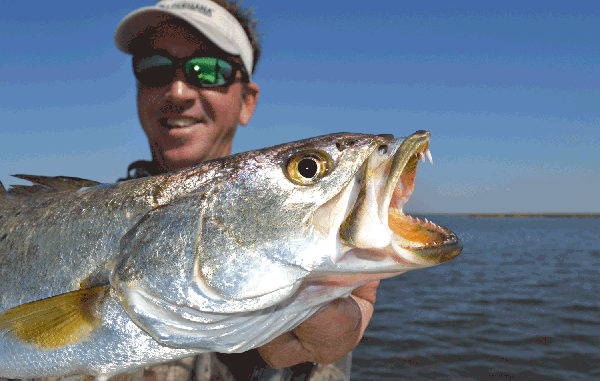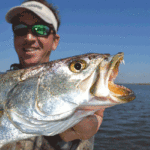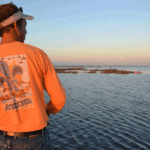
Delacroix speckled trout don’t typically camp out this time of year. You need to move with them if you want to consistently reach your limits.
If you live in the northern tier of the United States during the month of January, you’d better really like your wife.
The weather is remarkably consistent, and it’s consistently horrible.
The snow doesn’t come down in nice, pretty, little flakes that float back and forth on gentle pillows of fluffy air. It storms from the heavens in torrents that make Hurricane Sandy seem like a summer shower.
If you don’t have one of those fancy snow blowers or a fast-shoveling 12-year-old son fond of child abuse, that lovely combination of ice and air will collect in minutes into massive drifts that will completely hide your home. Open your front door, and you’ll be faced with a wall of white with a cute little indentation where your doorknob once was.
You won’t be going anywhere for a while — maybe until the end of February — and if you started the winter just on this side of the teeter-totter of sanity, you won’t make it nearly that long before you start going all Jack Nicholson in The Shining.
“Heeeeeeerrrrreeee’s Johnny!!”
But if you live in South Louisiana, January’s weather is about as consistent as a woodcock’s flight. You might literally be wearing shorts one day and your full-length, Thinsulate-stuffed camo coveralls the next.
If variety is the spice of life, the weather is a bowl of five-alarm chili down here in January.
That can make life even more confusing for trout fishermen than it is for the trout.
Think you’ve got the fish figured out? Think you’ve got them located just because you caught them in one spot yesterday?
Ha ha ha! Think again.
They’ll move with the capricious whims of the winter weather, trying to put something — ANYTHING! — in their shriveled bellies. Those trout that hit like dish rags on your barely-moving soft plastics at the bottom of a cavernous hole one day may be cavorting on a warming, sun-soaked flat the next.
Capt. Jack Payne, owner of Sweetwater Marina in Delacroix, has seen it over and over and over again.
“When you fish in January, it’s a 50/50 chance to find them on the flats or in the deep water,” Payne said. “It’s not cold every day in Louisiana — thank God, or I couldn’t do what I do because I’m a warm-weather guy.
“It warms up a lot in January, and when it does, that’s when you want to get out of the deeper holes and fish the flats.”
The flats are especially productive in the afternoon hours when a beaming sun has had all day to warm them. Bait stocks are pathetically small in the winter, but trout instinctively know these warm flats are where the bait will hang out. A trout getting just one meal this month can mean the difference between seeing the spring cornucopia or turning into a wintertime meal for a crab.
During Indian summer days, it’s often not even necessary to wait for the afternoon to have success on the flats. Payne pays close attention to the recent weather as well as the water temperature.
“When that water gets back up toward 60 degrees, after it warms up a little bit, you just fish your normal areas on the flats, right off the deepwater edges,” he said. “One day you catch them in the deep water, and the next day — BOOM! — they’re in all the shallow water, and you’re slaying them again.”
And that seems to be the key. Successful anglers in the winter are those who realize the fish never move very far from their wintertime holes. When they’re on the flats and a front moves through, it’s only a few flicks of the tail before they’re back in the shelter of the deep water.
“The Little Crevasse is a good example,” Payne said. “It’s not more than 6 feet deep, but just east of the Little Crevasse, they’ve got the bayou that takes you into Bakers Bay, and that’s real deep water right there — 15 to 20 feet in some areas.
“The fish come right out that deep water, and get in the Little Crevasse. That’s always a hotspot in the later winter months.”
The month of January is especially unkind to anglers with set schedules who can fish only one day a week. You might luck out and have that off day fall on a good-weather day, but more times than not,you’re going to be sitting at home watching Bill Dance reruns.
Far more fortunate are anglers who can pick their days off of work and fish when the conditions are right.
“The day before the front is the greatest day around,” Payne said. “But once the front comes through, it’s a two-day event before you’re going to get back on the fish.”
If the front is particularly stout, the fish will move to the deep holes and completely shut down.
“In the days when the water gets below 50 degrees, the fishing gets tough,” Payne said. “The redfish stay on the whole time, but the trout — they’ll only bite when that water’s above 50 degrees.”
More typically, though, the fronts knock the fish into the deep holes and the weather moderates enough that the fish will resume feeding before they ever emerge again.
When that happens, Payne simply follows them there, but he dramatically changes his fishing strategy.
He leaves the popping corks in his tackle box and focuses on the deep holes.
“You throw it out there, let it hit the bottom and you just want to barely move it,” Payen explained. “The fish are cold; they’re not moving much. They’re not going to chase a fast bait.
“That’s what a lot of people do wrong when they’re fishing on the bottom. They try to work it fast, like you do in the summertime. You want to throw it out there, and just let it sit. That trout might be right next to the bait. When you twitch it, he might not hit it that time, but when you move it again — BOOM! — he’ll hit it.”
Fishing a particular color is not nearly as important as fishing in areas that are holding fish. In the wintertime, one waterway in particular is ground zero for hot action, Payne said.
“The Pencil Canal takes you into wintertime heaven,” he said.
Payne explained that the Pencil Canal itself isn’t necessarily a hotspot, but it provides access to the slam-dunk winter spots, particularly Lake Batola, Pointe Fienne, Bay Jack Nevette and Baker’s Bay.
One other hot wintertime lake isn’t marked on most maps.
“A lot of people don’t realize where Skippy Lake is,” Payne said. “It’s the last big bay before you hit Oak River.”
In all these relatively shallow lakes, Payne’s strategy is simple: He drifts the flats throwing soft-plastics or live shrimp (see sidebar) under popping corks until he finds the fish. When he runs across trout, he sticks his Cajun anchor until the bite plays out, and then he resumes the drift.
On those cold days when the fish are deep, Payne abandons the Pencil Canal and focuses on Oak River. Some anglers do nothing but drift Oak River, bouncing soft plastics along the bottom, and return to the dock consistently with limits.
Payne often does that, as well, but he focuses his efforts on the intersection of the Spider Pipeline with Oak River, as well as the intersection of the Twin Pipeline with Oak River.
“Those are great spots to fish on the bottom,” he said.
You know we’ll have days like that this month in South Louisiana. It’s a guarantee. As the old saying goes, “If you don’t like the weather, wait 15 minutes. It’ll change.”
And when it does, all you have to do is follow the fish.
Editor’s note: For more information, contact Capt. Jack Payne at 504-453-8382.


